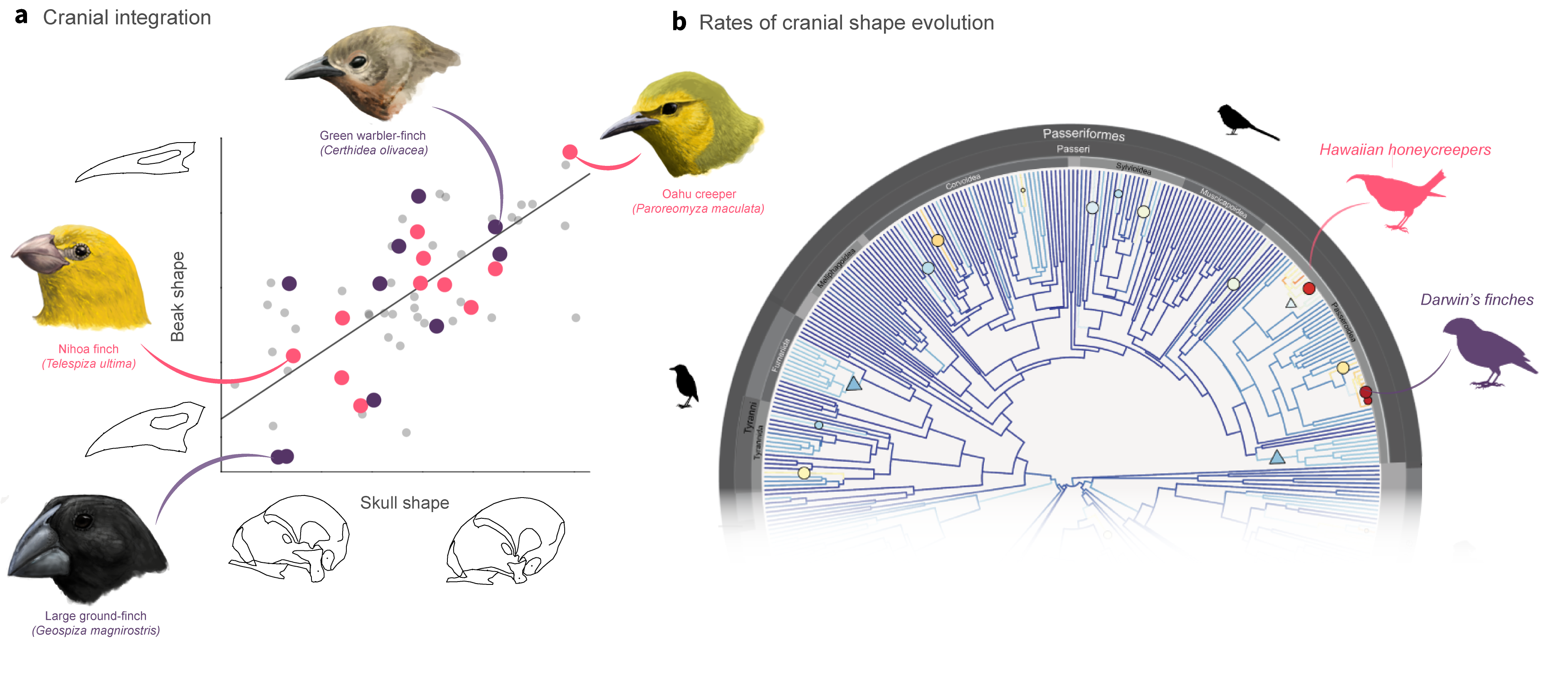The skull evolved as an integrated unit in Darwin's finches and Hawaiian honeycreepers and that may have been a key factor to their success
Published in Ecology & Evolution

Darwin’s finches are among the most celebrated examples of adaptive radiation in evolution. First studied by Darwin, many years of field research have led to a detailed understanding of the ecology and biology of these island birds. Yet it transpires that Darwin’s finches, and another group of island birds, the Hawaiian honeycreepers (true finches unlike Darwin’s finches which are actually tanagers belonging to the family Thraupidae), are evolutionary outliers. Both groups evolved much faster than other birds that colonised the Galapagos and Cocos or the Hawaiian island archipelagos at similar times. In fact, Darwin’s finches and Hawaiian honeycreepers are among the most rapidly evolving clades within modern bird diversity.

In the current volume of Nature Ecology & Evolution we address the question of rapid evolution and show that one of the key factors related to the evolutionary success of Darwin’s finches and Hawaiian honeycreepers might lie in how their beaks and skulls evolved.
Previous studies have demonstrated a tight link between beak shape, size and ecology in both clades suggests that feeding adaptation may have been one of the main processes driving their evolutionary radiations. Furthermore, changes in beak size and shape have been observed in natural populations of Darwin’s finches as a response to variations in feeding resources, strengthening these views.
However, recent studies on other groups of birds, some of which stem from our own previous research, have suggested that this strong match between beak and cranial morphology and ecology might not be pervasive in all birds. Other factors such as constraints on skull shape during development, the use of the beak for many other functions and the fact that the skull and beak develop and function as a coherent unit may have contributed to this mismatch. Therefore, the strong connection between beak, cranial morphology and feeding ecology over the evolution of Darwin’s finches, Hawaiian honeycreepers, and perhaps other lineages of birds, might have been only possible if this tight coevolution of cranial regions is somehow ‘relaxed’ and those regions are able to evolve more ‘freely’.
Surprisingly, in our study we found largely the opposite.
By taking a broad scale, quantitative look at more than 400 species of landbirds (the group that encompasses all perching birds and many other lineages such as parrots, kingfishers, hornbills, eagles, vultures, owls and many others) we found that the beaks of Darwin’s finches and Hawaiian honeycreepers evolved in a stronger association with the rest of the skull than in most of the other lineages of landbirds. In other words, in these groups the beak is less independent in evolutionary terms than in most other landbirds.

Yet this tight association was perhaps one of the keys to their success: we found that as a result of this stronger “cranial integration”, these birds mostly evolved along a very specific direction of adaptive change in cranial shape. This allowed them to evolve many different shapes very rapidly, filling many of the available niches in their archipelagos as a result. In contrast, the other sympatric bird lineages that occupied the island archipelagos at similar time to the ancestors of finches and honeycreepers all belong to the group with the lowest cranial integration in our study. Perhaps this was a limiting factor for rapid cranial radiation in these other lineages?
Our results challenge previous ideas in evolutionary theory by providing an empirical case which suggests that stronger covariation of traits can produce bursts of evolution rather than serving solely as a factor limiting evolvability of organisms.
While these results are exciting, there is still much more work to do and several questions remain unanswered. For instance, when in the evolution of the clade including both Darwin’s finches and Hawaiian honeycreepers did this stronger cranial integration originate? Did these associations in the skull of Darwin’s finches and Hawaiian honeycreepers also affected other traits? Are these associations between traits arising from the development of the skull over ontogeny, or are these reflecting functional associations, or both? Are these evolutionary situations isolated phenomena in these two archipelagos or have those been more common in the evolution of island or continental avifaunas? Do these patterns characterise other adaptive radiations in birds? Future research will likely solve at least some of these conundrums, bringing us one step closer to understanding better the drivers behind the evolution of the wonderful diversity of shapes in birds.
To read more, read the paper following the link: https://www.nature.com/articles/s41559-019-1092-y
Follow the Topic
-
Nature Ecology & Evolution

This journal is interested in the full spectrum of ecological and evolutionary biology, encompassing approaches at the molecular, organismal, population, community and ecosystem levels, as well as relevant parts of the social sciences.
Related Collections
With Collections, you can get published faster and increase your visibility.
Understanding species redistributions under global climate change
Publishing Model: Hybrid
Deadline: Jun 30, 2026

Please sign in or register for FREE
If you are a registered user on Research Communities by Springer Nature, please sign in